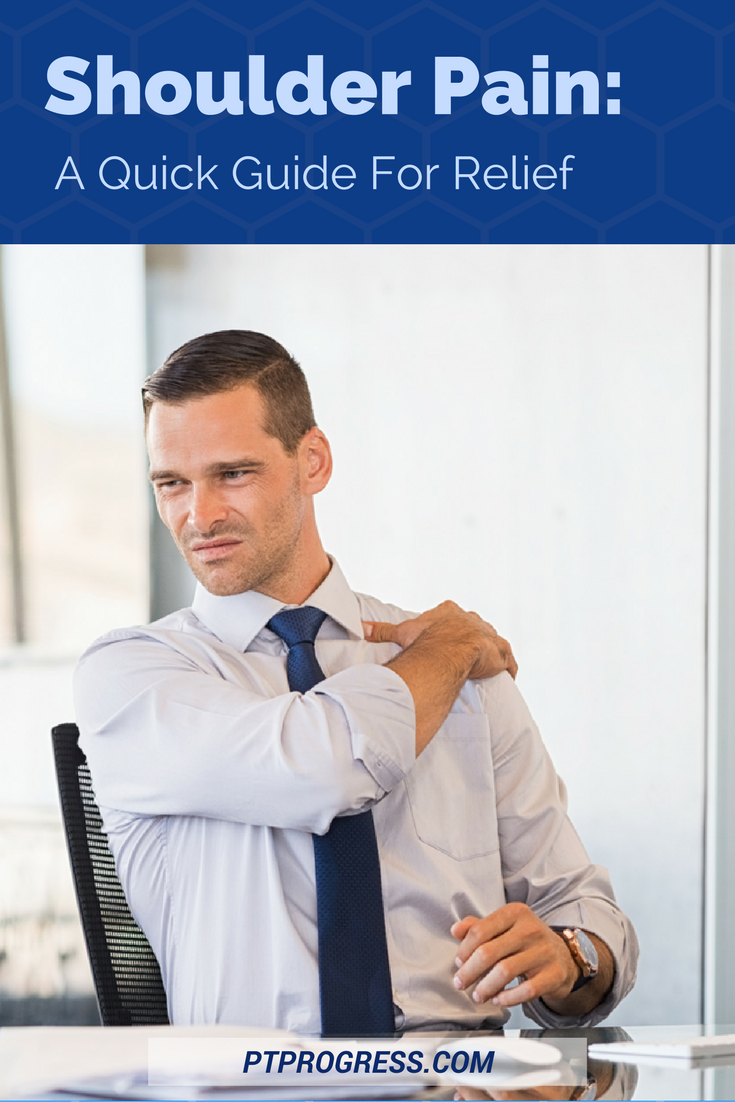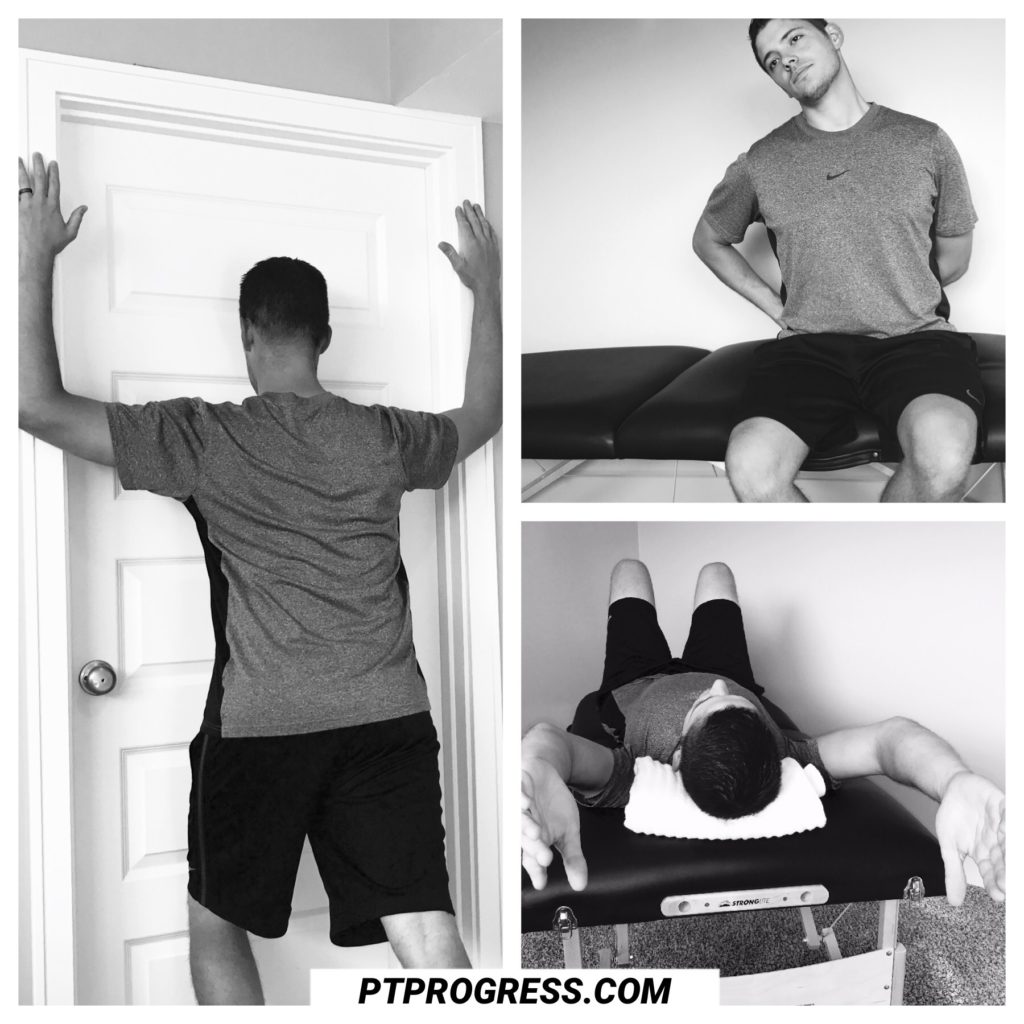
According to the orthopedic site orthoinfo.org, most cases of shoulder pain can be classified into the following groups:
- Tendon Inflammation or Tear
- Shoulder Instability
- Arthritis
- Fracture
The good news is that many treatment options are overlapping for these issues. However, it’s always smart to check with your physician or Physical Therapist to understand the most appropriate way to treat your shoulder.
In the case of a shoulder fracture, you should follow your doctor’s orders so that your bone heals appropriately before engaging in any exercises or stretches.
Let’s look at some common ways to relieve the different types of shoulder pain.
Tendon Inflammation or Rotator Cuff Tears
If you’ve experienced a gradual onset of shoulder pain or have pain in your shoulder after excessive use, you might be suffering from inflammation or even a tear.
Your first line of defense should be to stop or decrease the painful movements.
If your doctor recommends physical therapy for strength and flexibility training, consider the following exercises and stretches for your shoulder.
Word of Caution
It’s important to note that you should avoid sharp pain with exercises as you might be damaging the tissues further. Be patient and focus on slow, smooth motion when performing exercises like these.
As a Physical Therapist, I often caution my patients to focus more on the quality of their movement and less on the quantity. This is especially true when you’re first performing these new exercises because you are using muscles that are weak or possibly injured.
Scapular Retraction: Mid and Low Row
- Think about squeezing your shoulder blades ‘down and in’ towards your back pockets.
- Perform 2 to 3 sets of 10 repetitions.
- The bands I am using are from Black Mountain and cost about $25 on Amazon.

Shoulder Isometric Press
- Gently press into towel for 5 to 10 seconds, repeating 10 times each direction.
- Do not strain. Apply just enough pressure to engage the muscles.

Wall Slide with or without Resistance Band
- With your neck relaxed, place arms at shoulder height and width.
- Slowly slide arms into a “Y” at the wall. Don’t use band if there is pain.
- Perform 2 to 3 sets of 10 repetitions

Sidelying External Rotation
- Lie on your side with a towel under your arm and head supported.
- With a very light motion, slowly rotate arm upward towards ceiling.
- 2 to 3 sets of 10 repetitions. Do with 0#. No weight.

Safe Stretches to Relieve Shoulder Pain
Upper Trapezius Stretch: If possible, place your arms behind your back, creating a ‘chicken wing’ on one side. Gently tilt your head towards the ‘winged’ arm and hold for 20 to 30 seconds. You can also gently look down for a variation of this stretch to the upper trapezius.
Pec Minor Stretch: Lie down on a flat surface. Make a ‘touchdown’ sign with your arms and slowly extend your arms. You should feel a stretch along the inside of your armpit and chest. If your hands are getting a numb/tingling feeling, don’t stretch so far. You can also perform a variation of this stretch at a doorway or corner as shown in the pictures.

Shoulder Instability or Impingement
I’m grouping the two of these shoulder injuries together because of the common tie between them: poor movement patterns.
Your shoulder is a ball and socket joint that should rotate and glide smoothly and precisely. If you have poor movement of the shoulder, it could lead to impingement of the tendons and soft tissue around the joint.
In a similar way, shoulder instability (from overuse or injury) can lead to dislocation or subluxation.
The focus of therapy for these issues may center around strengthening and stability training for the shoulder.
Here are 3 Exercises that focus on precise motion and shoulder stability.
Sidelying External Rotation (See image/instructions above)
Wall Slides (See image/instructions above)
Ball Circles at Wall
- Stand with your shoulders squared and with your arm outstretched holding a ball or small towel at the wall.
- Use small circular motions clockwise and counterclockwise to work on endurance and stability of the shoulder.
- Perform for 30 seconds and take breaks to maintain good form. Repeat 5-10 times.
Relieving Arthritis in the Shoulder
There are many types of arthritis, but the most common type of arthritis for the shoulder is Osteoarthritis. This is from overuse or a wearing of the joint over time.
Arthritis can make your joint feel stiff and painful with movements, restricting your range of motion.
Your physician may recommend medication for inflammation or even surgical intervention to resolve the pain limited mobility caused by arthritis.
If your physician recommends exercises and stretches for maintaining mobility in your shoulder consider these.
- Assisted ROM with Golf Club
- Pendulum Arm Swings
- Slide Arm Along Stair Handrail for Stretch
- Apply Ice to relieve inflammation
Other Ways to Relieve Shoulder Pain
Here’s the deal with shoulder braces: they can provide temporary support to your shoulder, but should not be considered a long term solution.
Shoulder Braces
Your shoulder muscles make for the best long term support, which is why exercise and stability training can really make a difference.
That said, a compression brace for your shoulder might provide relief early on and support throughout the day as you are strengthening your shoulder.
Compressive shoulder braces run around $20 on Amazon, so it won’t break the bank if you’re looking for something to provide shoulder relief.
- ✅ END THE PAIN - Dramatically reduce shoulder pain, discomfort, inflammation. Accelerate joint and tendon injury recovery - proper support,...
- ✅ SUPPORT YOU BADLY NEED! - Sparthos Shoulder Brace has been carefully engineered to stabilize and support your shoulder. Won't restrict! It will...
Kinesiotape for Shoulder
I like to use Kinesiotape in the clinic to support the shoulder and to provide pain relief. Again, I consider it a short term solution, but it really can provide pain relief.
Applying the tape to your own should may take some practice, but it’s possible!
You can find kinesiology tape on Amazon or at your local sports store or pharmacy store for about $15.
Here’s a quick way to support the shoulder: Cut a strip about 8 inches long. Create a “Y” by cutting the tape lengthwise. Place the ‘base’ of the tape at the mid point of your shoulder. Bring arm forward, apply a 50% stretch to tape, place tape towards the back side of shoulder. Next, bring arm backwards, apply a 50% stretch to tape, lay tape along the front side of your shoulder.
Always apply the end of the kinesiology tape with zero stretch to avoid blistering. Follow the instructions for use of the tape found on the box. Generally, you want to remove the tape within 48 hours of application.

EStim (Tens Unit)
Using a Tens Unit is an effective way to manage should pain as long as your doctor or Physical Therapist recommends its use. EStim (Tens Units) aren’t appropriate for everyone, so make sure you read the precautions and manufacturer’s instructions carefully before use.
There are many products on the market, but I recommend finding a reputable manufacturer. Here is a TENS unit that I have used in the clinic to treat shoulder pain. It’s not the cheapest, but sometimes you get what you pay for.
If you have shoulder pain at night, check out the entire article that teaches you how to stop shoulder pain when sleeping,
What are some strategies that you’ve implemented to manage shoulder pain?



Thanks for showing me different ways that I can relieve some shoulder pains. I have been a swimmer ever since I can remember, and because I am getting older, I cannot swim butterfly like I used to. Like you said here about inflammation, I will stop swimming butterfly for the meantime and decrease all painful movements. My shoulders have definitely seen better days, and I will make sure to see a physical therapist if the pain continues despite this first line of defense. Thanks again!
Nice article. Unfortunately, I have a built in CRTD with defibrillator, so no Tens. And level 5 kidney disease, so no Nsaids or Ibuprofen. Guess I will see about shots, if we ever start face to face visits.